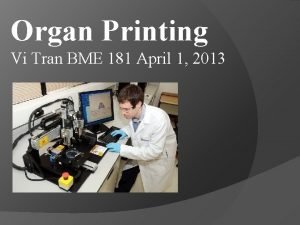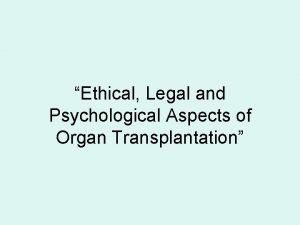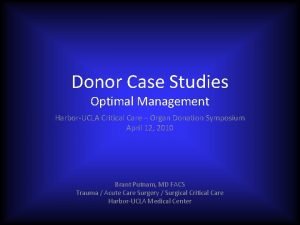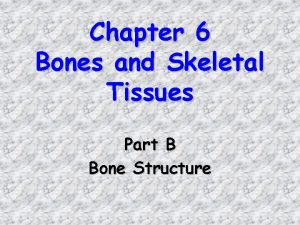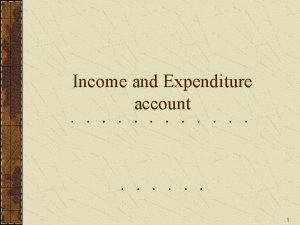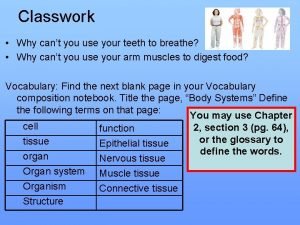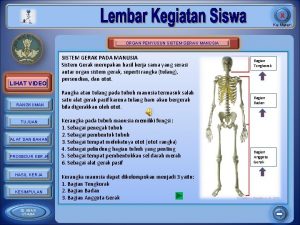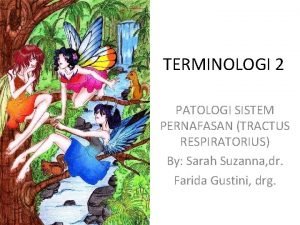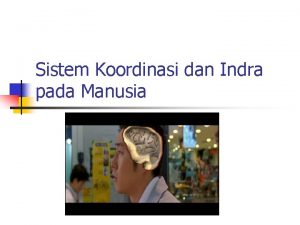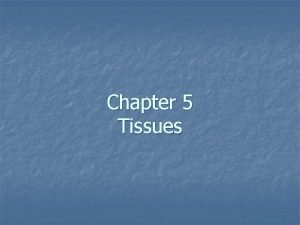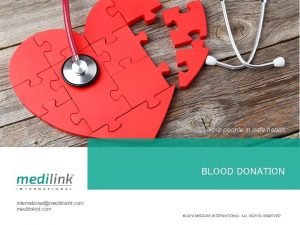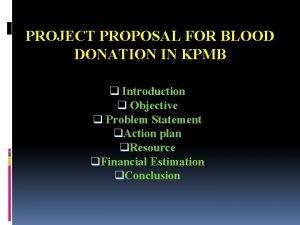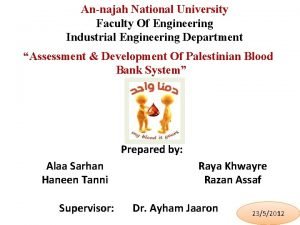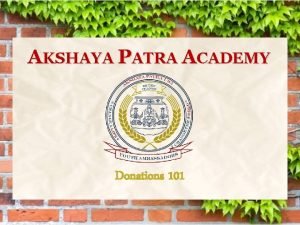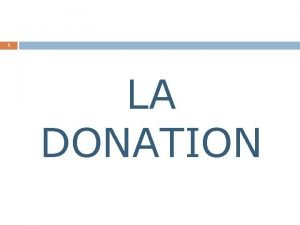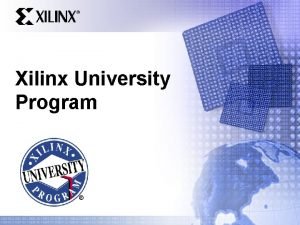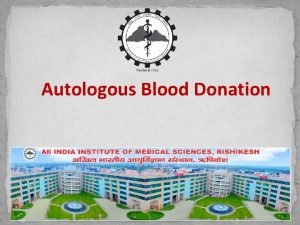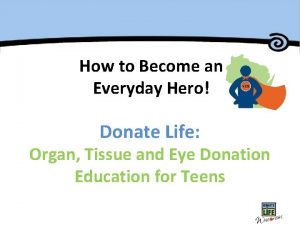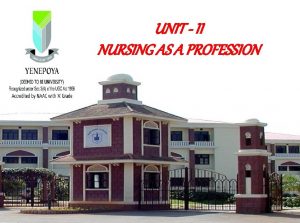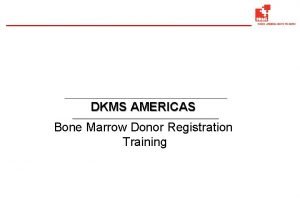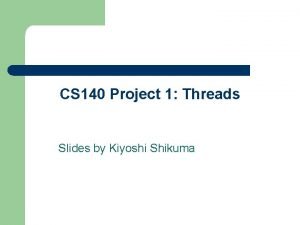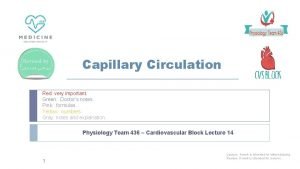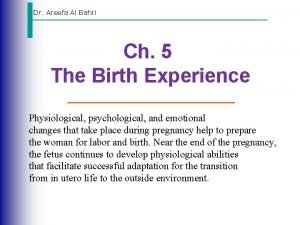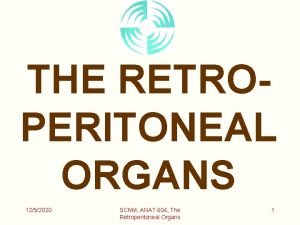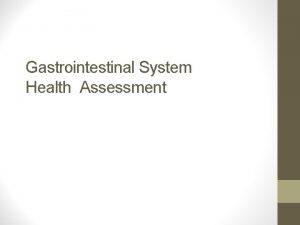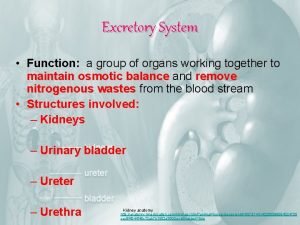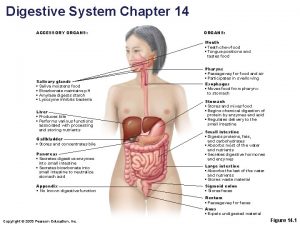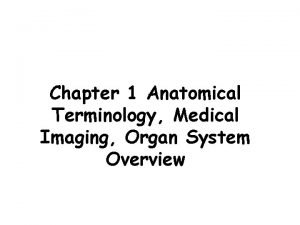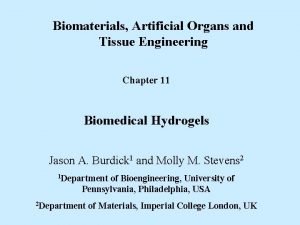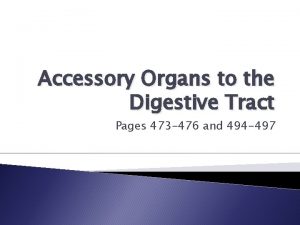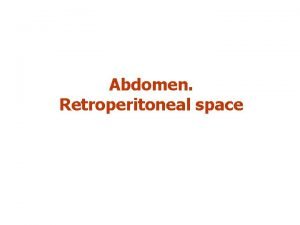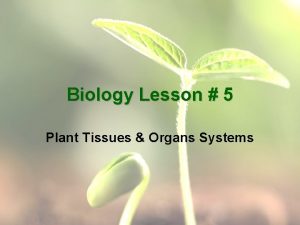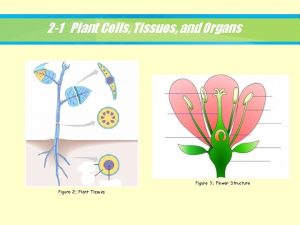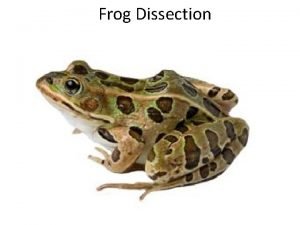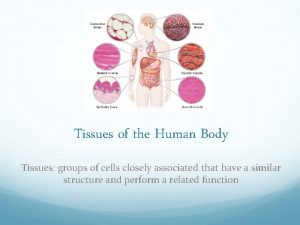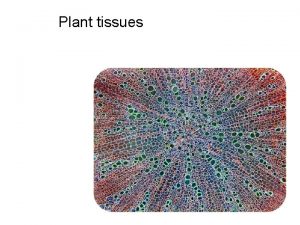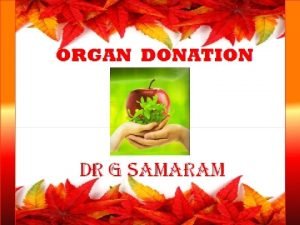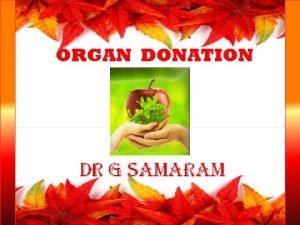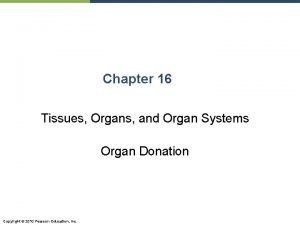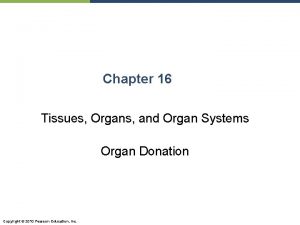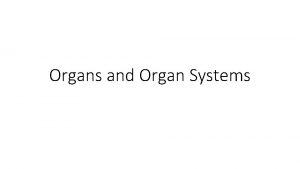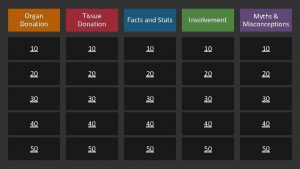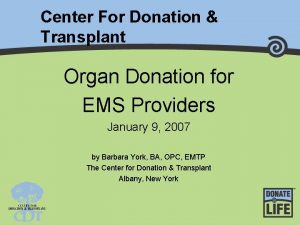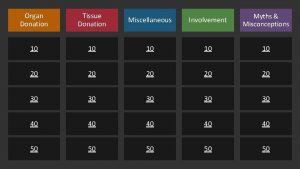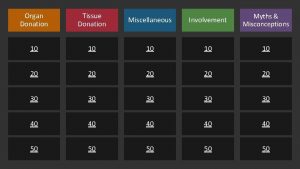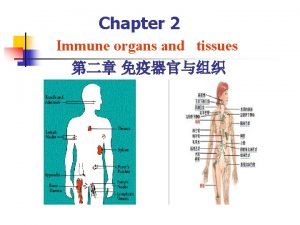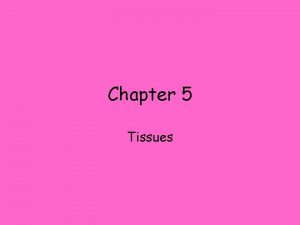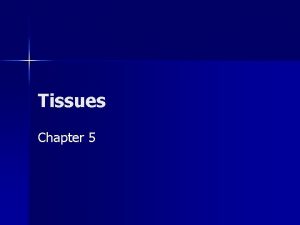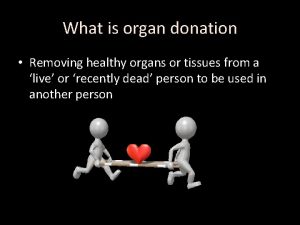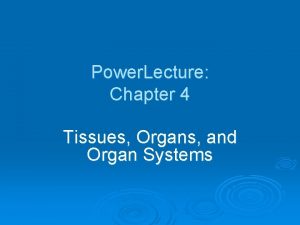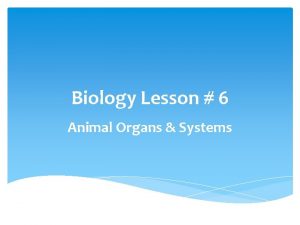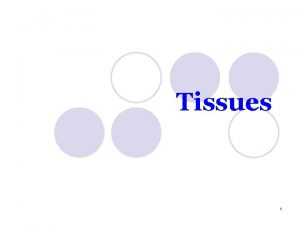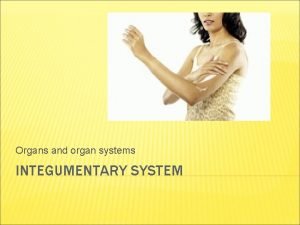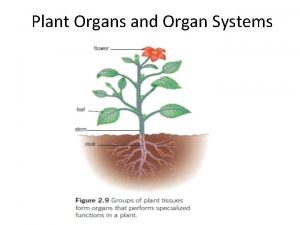Chapter 11 Organ Donation Tissues Organs and Organ























































- Slides: 55

Chapter 11 Organ Donation Tissues, Organs, and Organ Systems Fourth Edition BIOLOGY Science for Life | with Physiology Colleen Belk • Virginia Borden Maier © 2013 Pearson Education, Inc. Copyright © 2009 Pearson Education, Inc. Power. Point Lecture prepared by Jill Feinstein Richland Community College

1 Tissues § Tissues – group of similar cell types that perform a common function § The human body has four basic types of tissue: § Epithelial § Connective § Muscle § Nervous © 2013 Pearson Education, Inc.

1 Tissues – Epithelial Tissue § Epithelium is tightly packed sheets of cells that line organs and outer surfaces, as well as the insides of hollow organs, vessels, and body cavities. § Epithelia are typically anchored on one face, but free on another § The free side is typically exposed to the environment of body fluids § Can be single layer or many layers thick § Function in protection, secretion, and absorption § Epithelial cells are continuously sloughing off and are replaced by cell division © 2013 Pearson Education, Inc.

1 Tissues – Epithelial Tissue § Many organs are lined with epithelial tissue © 2013 Pearson Education, Inc.

1 Tissues – Connective Tissue § Loosely organized and composed of cells embedded in a matrix § Matrix is composed of protein fibers and ground substance § Usually binds organs or tissues to one another § Six different types: § Loose connective tissue § Adipose tissue § Blood § Fibrous connective tissue § Cartilage § Bone © 2013 Pearson Education, Inc.

1 Tissues – Connective Tissue § Loose connective tissue § Most widespread tissue in animal body § Matrix composed of collagen and elastin fibers § It is called “loose” because of the fibers that are loosely woven together § Binds epithelia to tissues, pads skin, and holds organs in place © 2013 Pearson Education, Inc.

1 Tissues – Connective Tissue § Adipose tissue § Also called fat § Connects skin to underlying structures, pads organs § Used for storage of energy (fat) § Primarily cells; small amount of matrix © 2013 Pearson Education, Inc.

1 Tissues – Connective Tissue § Blood § Cellular component, red blood cells, white blood cells and platelets § Matrix is the plasma § Functions include carrying oxygen and nutrients; fighting infection © 2013 Pearson Education, Inc.

1 Tissues – Connective Tissue § Fibrous connective tissue § Forms tendons and ligaments § Matrix is densely packed collagen fibers running in parallel. © 2013 Pearson Education, Inc.

1 Tissues – Connective Tissue § Cartilage § Cellular component chondrocytes § Chondrocytes secrete own matrix § Cartilage cushions joints, forms support for ears and nose § Not vascularized, so takes a long time to heal if injured © 2013 Pearson Education, Inc.

1 Tissues – Connective Tissue § Bone § Rigid connective tissue § Osteoblasts secrete matrix that is composed of collagen fibers and calcium salts § Osteocytes maintain the hardened bone matrix § Body can make use of calcium from bones if dietary levels are too low © 2013 Pearson Education, Inc.

1 Tissues – Muscle Tissue § Muscle is contractile tissue (capable of shortening) § Long, thin cylindrical cells called muscle fibers § Two proteins – actin and myosin – interact to cause contraction of muscle fibers § Three types of muscle: § Skeletal § Cardiac § Smooth © 2013 Pearson Education, Inc.

1 Tissues – Muscle Tissue § Skeletal Muscle § Usually attached to bone § Produces all voluntary movements § Striated § Long, thin, cylindrical shape © 2013 Pearson Education, Inc.

1 Tissues – Muscle Tissue § Cardiac muscle § Only found in heart tissue, undergoes rhythmic contractions to produce heartbeat § Striated and involuntary § Branched, interlocking cells propagate signal to contract almost simultaneously © 2013 Pearson Education, Inc.

1 Tissues – Muscle Tissue § Smooth muscle § Not striated and involuntary § Musculature of organs, blood vessels, digestive tract § Contracts more slowly and for longer than skeletal muscle © 2013 Pearson Education, Inc.

1 Tissues – Nervous Tissue § Neurons conduct electrical signals and compose the cells of the brain and spinal cord § Main functions of neurons are to: § Sense stimuli § Process stimuli § Transmit signals § Most cells of nervous system do not undergo cell division © 2013 Pearson Education, Inc.

1 Tissues – Nervous Tissue © 2013 Pearson Education, Inc.

1 Tissues – Tissue Donation § One person’s tissues can improve the lives of as many as 50 people. § Injuries from motor vehicle accidents, burst blood vessels, and drowning are common causes of brain death. § Once dead, brain cells cannot recover. § Brain dead is different than being in a coma or vegetative state. § Tissues can be treated to remove any proteins that a person’s immune system may react to so there is no need for donor matching. © 2013 Pearson Education, Inc.

2 Organs and Organ Systems § Organs are composed of two or more tissue types § Organs that act together from an organ system § All the organ systems of a body form an organism © 2013 Pearson Education, Inc.

2 Organs and Organ Systems – The Liver as a Model Organ § The liver sits below the diaphragm, is comprised of four lobes, and is associated with the gall bladder. § The lobes are subdivided into lobules which each contain a central vein and hepatocytes. § The central vein allows blood to circulate through all of the liver. © 2013 Pearson Education, Inc.

2 Organs and Organ Systems – The Liver as a Model Organ § The liver is an important component of the digestive and the circulatory system § As part of the circulatory system, the liver: § Synthesizes blood clotting factors § Detoxifies § Regulates blood volume § Destroys old red blood cells § As part of the digestive system, the liver: § Produces bile § Metabolizes and stores nutrients © 2013 Pearson Education, Inc.

2 Organs and Organ Systems – The Liver as a Model Organ § Liver transplants can be made from living donors or from brain dead ones § Unlike many organs, liver can regenerate itself § Portion can be taken from living donor and implanted in patient § Liver in donor and patient will regrow to normal size © 2013 Pearson Education, Inc.

2 Organs and Organ Systems – The Digestive System § The digestive system’s role in the body is to chemically and mechanically break down food into nutrients which then can be absorbed. § This process starts in the oral cavity with the teeth performing mechanical digestion. § Salivary amylase performs chemical digestion in the oral cavity. § The tongue helps you taste food and to form a bolus. © 2013 Pearson Education, Inc.

2 Organs and Organ Systems - The Digestive System © 2013 Pearson Education, Inc.

2 Organs and Organ Systems – The Digestive System § Once the bolus is in the stomach, peristalsis further breaks down the food into chyme. § Chyme is the combination of digested food with gastric juices. § Once in the small intestine the chyme is completely broken down into nutrients. § The nutrients are now ready for absorption. © 2013 Pearson Education, Inc.

2 Organs and Organ Systems – The Digestive System § Villi and microvilli increase the surface area of the intestines to allow nutrient absorption. © 2013 Pearson Education, Inc.

2 Organs and Organ Systems – Regulation of Digestive Secretions § Regulation of the digestive system occurs hormonally. § Gastrin produce from the stomach stimulates more gastric juices to be released. § Cholecystokinin and secretin are produced by the small intestine and they trigger the pancreas and gallbladder to release their contents. © 2013 Pearson Education, Inc.

2 Organs and Organ Systems – Regulation of Digestive Secretions § Organ system consists of many organs working together. § Failure of one organ may compromise the entire system. § Intestine transplants and pancreatic transplants are becoming more common. § Gall bladder transplants are rarely done because a person can live fine without one. § Organ failure can also disrupt multiple systems. © 2013 Pearson Education, Inc.

Animation: The Digestive System Click “Go to Animation” / Click “Play” © 2013 Pearson Education, Inc.

3 Regulating the Internal Environment § Homeostasis is the ability to maintain a constant internal environment under changing conditions. § Thermoregulation is the regulation of temperature to maintain homeostasis. § Endotherms maintain body temperature internally and warmer than the surrounding environment. § Humans and mammals are examples. § Ecotherms obtain their body heat from the surrounding environment. § Most invertebrates, fish, amphibians and reptiles are examples. Bio. Flix: Homeostasis © 2013 Pearson Education, Inc.

3 Regulating the Internal Environment – Negative Feedback § Negative feedback occurs when the stimulus that triggered the change in the body is reversed. © 2013 Pearson Education, Inc.

3 Regulating the Internal Environment – Positive Feedback § Positive feedback occurs when the outcome of a process increases or intensifies the stimulus for that process. § During childbirth, hormones cause muscles of uterus to contract. § Uterine contractions cause even more hormones to be released, which intensify the contractions. § In animals, regulation is usually by negative feedback because positive feedback often results in amplification – away from homeostasis. § Other examples of positive feedback are testosterone production and urination. © 2013 Pearson Education, Inc.

3 Regulating the Internal Environment – Organ Donation § The best candidates to donate organs are those who have died of brain injury. § In cardiac death, organs deteriorate due to lack of oxygen, and thus are less suitable for transplant. § Thousands of lives are saved each year through organ donation. § The decision to become a donor now can save families from making difficult decisions later. © 2013 Pearson Education, Inc.

Which one of the following tissues is found lining the stomach? § epithelial § connective § muscle § nervous © 2013 Pearson Education, Inc.

Which one of the following tissues is found lining the stomach? § epithelial § connective § muscle § nervous © 2013 Pearson Education, Inc.

What type of cells make up cartilage? § chondrocytes § fibroblasts § osteocytes § hepatocytes © 2013 Pearson Education, Inc.

What type of cells make up cartilage? § chondrocytes § fibroblasts § osteocytes § hepatocytes © 2013 Pearson Education, Inc.

Skeletal muscle controls _______ actions, cardiac muscle controls _______actions, and smooth muscle controls _______ actions. § voluntary; involuntary; voluntary § voluntary; involuntary § involuntary; voluntary © 2013 Pearson Education, Inc.

Skeletal muscle controls _______ actions, cardiac muscle controls _______actions, and smooth muscle controls _______ actions. § voluntary; involuntary; voluntary § voluntary; involuntary § involuntary; voluntary © 2013 Pearson Education, Inc.

The liver produces bile. What is the function of bile? § Bile destroys old blood cells. § Bile synthesizes blood-clotting factors. § Bile helps metabolize fats through emulsification. § Bile regulates blood volume. © 2013 Pearson Education, Inc.

The liver produces bile. What is the function of bile? § Bile destroys old blood cells. § Bile synthesizes blood-clotting factors. § Bile helps metabolize fats through emulsification. § Bile regulates blood volume. © 2013 Pearson Education, Inc.

True or False: The term brain dead is the same as being in coma or vegetative state. § True § False © 2013 Pearson Education, Inc.

True or False: The term brain dead is the same as being in coma or vegetative state. § True § False © 2013 Pearson Education, Inc.

What is the name for the wave-like contractions that move food down the esophagus? § bolus § peristalsis § epiglottis § chyme © 2013 Pearson Education, Inc.

What is the name for the wave-like contractions that move food down the esophagus? § bolus § peristalsis § epiglottis § chyme © 2013 Pearson Education, Inc.

Which organ pictured here is the site where most of the digestion of nutrients occurs? § 1 – mouth § 4 – stomach § 5 – small intestine § 6 – large intestine © 2013 Pearson Education, Inc.

Which organ pictured here is the site where most of the digestion of nutrients occurs? § 1 – mouth § 4 – stomach § 5 – small intestine § 6 – large intestine © 2013 Pearson Education, Inc.

What organ produces many of the digestive enzymes used by the small intestine? § pancreas § gallbladder § duodenum § kidney © 2013 Pearson Education, Inc.

What organ produces many of the digestive enzymes used by the small intestine? § pancreas § gallbladder § duodenum § kidney © 2013 Pearson Education, Inc.

Which of the following statements is incorrect? § The most commonly donated organs are the liver, kidney, heart, and lungs. § People who die from cardiac death or brain injury are good candidates for donation. § Organ donors and recipients must have the same blood type. § Living donors can donate all of their liver. © 2013 Pearson Education, Inc.

Which of the following statements is incorrect? § The most commonly donated organs are the liver, kidney, heart, and lungs. § People who die from cardiac death or brain injury are good candidates for donation. § Organ donors and recipients must have the same blood type. § Living donors can donate all of their liver. © 2013 Pearson Education, Inc.

What organ is the black arrow pointing to? § Liver § Duodenum § Stomach § Pancreas © 2013 Pearson Education, Inc.

What organ is the black arrow pointing to? § Liver § Duodenum § Stomach § Pancreas © 2013 Pearson Education, Inc.

Which of the following describes negative feedback? § The stimulus that causes the changes in the body’s environment ends up enhancing the stimulus. § The stimulus that changes the body’s environment is reversed by the body reaction. § The stimulus causes nothing in the body to happen. § None are correct. © 2013 Pearson Education, Inc.

Which of the following describes negative feedback? § The stimulus that causes the changes in the body’s environment ends up enhancing the stimulus. § The stimulus that changes the body’s environment is reversed by the body reaction. § The stimulus causes nothing in the body to happen. § None are correct. © 2013 Pearson Education, Inc.
 Body tissues chapter 3 cells and tissues
Body tissues chapter 3 cells and tissues The four major categories of tissues are
The four major categories of tissues are Body tissues chapter 3 cells and tissues
Body tissues chapter 3 cells and tissues Anatomy chapter 3 cells and tissues
Anatomy chapter 3 cells and tissues Eisonophil
Eisonophil Disadvantage of organ donation
Disadvantage of organ donation Utilitarianism organ donation
Utilitarianism organ donation Organ donation case studies
Organ donation case studies Division of anatomy
Division of anatomy Organ and organ system
Organ and organ system Chapter 6 bones and skeletal tissues
Chapter 6 bones and skeletal tissues Chapter 3 cells and tissues figure 3-7
Chapter 3 cells and tissues figure 3-7 Cell membrane phospholipids
Cell membrane phospholipids Chapter 3 cells and tissues figure 3-1
Chapter 3 cells and tissues figure 3-1 Example of income and expenditure account
Example of income and expenditure account Cell tissue organ organ system organism
Cell tissue organ organ system organism Cells group together to form
Cells group together to form Organ penyusun gerak adalah
Organ penyusun gerak adalah Organ organ pernafasan
Organ organ pernafasan Organ penyusun sistem indra dan fungsinya
Organ penyusun sistem indra dan fungsinya Four principal types of tissue
Four principal types of tissue Blood donation disqualifications
Blood donation disqualifications Nashville egg freezing
Nashville egg freezing Blood donation project proposal
Blood donation project proposal Blood donation process flow chart
Blood donation process flow chart Akshaya patra donation online
Akshaya patra donation online Vedmata gayatri trust donation
Vedmata gayatri trust donation Acte de donation
Acte de donation Xilinx donation program
Xilinx donation program Timer_sleep pintos
Timer_sleep pintos Sperm donation greensboro nc
Sperm donation greensboro nc Blood donation definition
Blood donation definition Donation committee
Donation committee Everyday hero donation
Everyday hero donation Defination of nursing by who
Defination of nursing by who Dkms americas
Dkms americas Pintos priority donation solution
Pintos priority donation solution Capillary tissue fluid exchange diagram
Capillary tissue fluid exchange diagram Fetal station chart
Fetal station chart Primary and secondary retroperitoneal organs
Primary and secondary retroperitoneal organs 4 quadrants of abdomen
4 quadrants of abdomen What are the functions of excretory system
What are the functions of excretory system Mouth function in digestive system
Mouth function in digestive system Body quadrants and organs
Body quadrants and organs Biomaterials artificial organs and tissue engineering
Biomaterials artificial organs and tissue engineering Major and accessory organs of the digestive system
Major and accessory organs of the digestive system Retroperitoneal organs
Retroperitoneal organs Red and white blood cells difference
Red and white blood cells difference Plant tissue and organs
Plant tissue and organs Largest lymphoid organ
Largest lymphoid organ Plant tissue and organs
Plant tissue and organs Change of gases
Change of gases Frog dissection tools
Frog dissection tools Specialized connective tissue
Specialized connective tissue Http://www.biologycorner.com/anatomy/histology/
Http://www.biologycorner.com/anatomy/histology/ Plant tissue
Plant tissue





